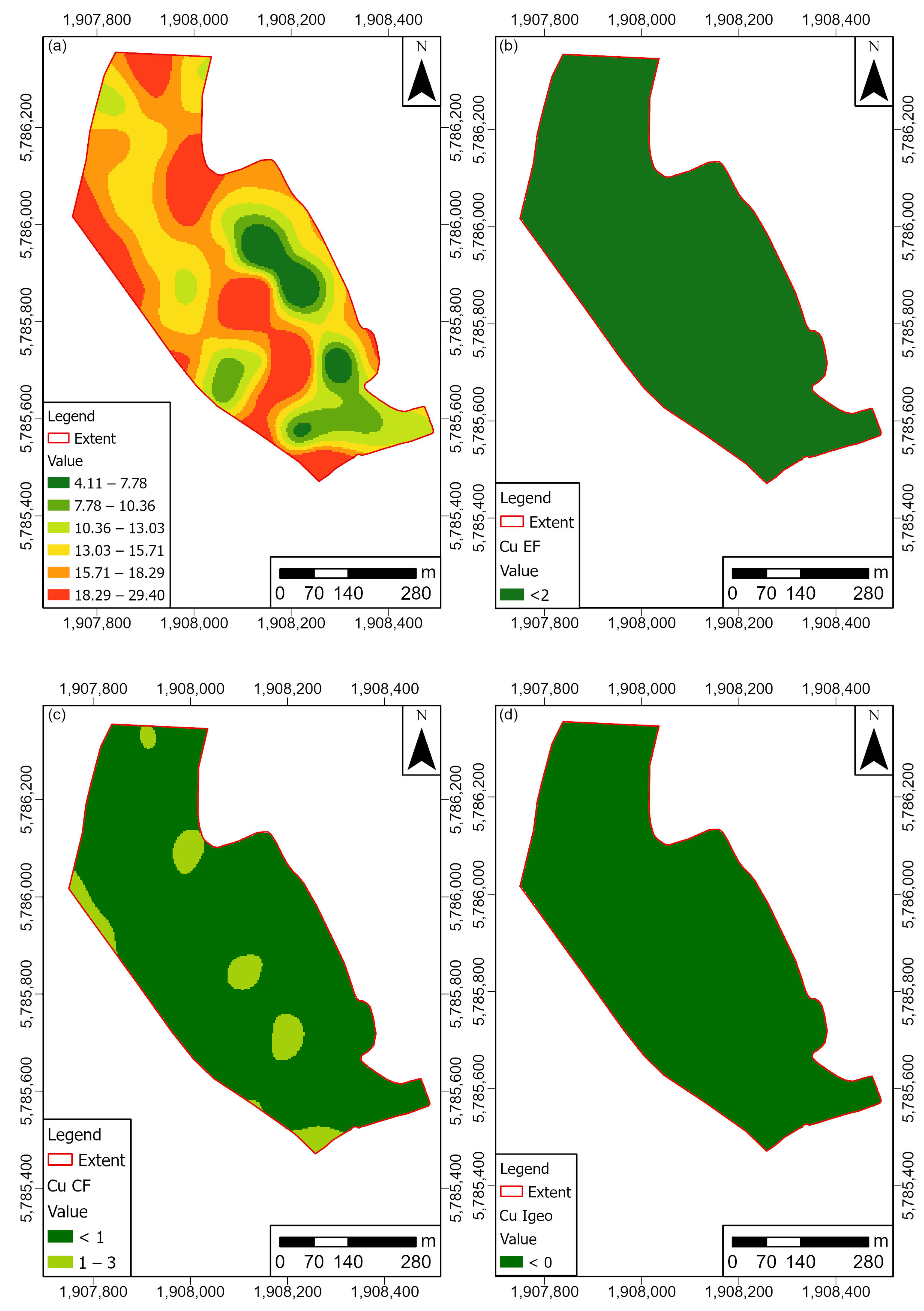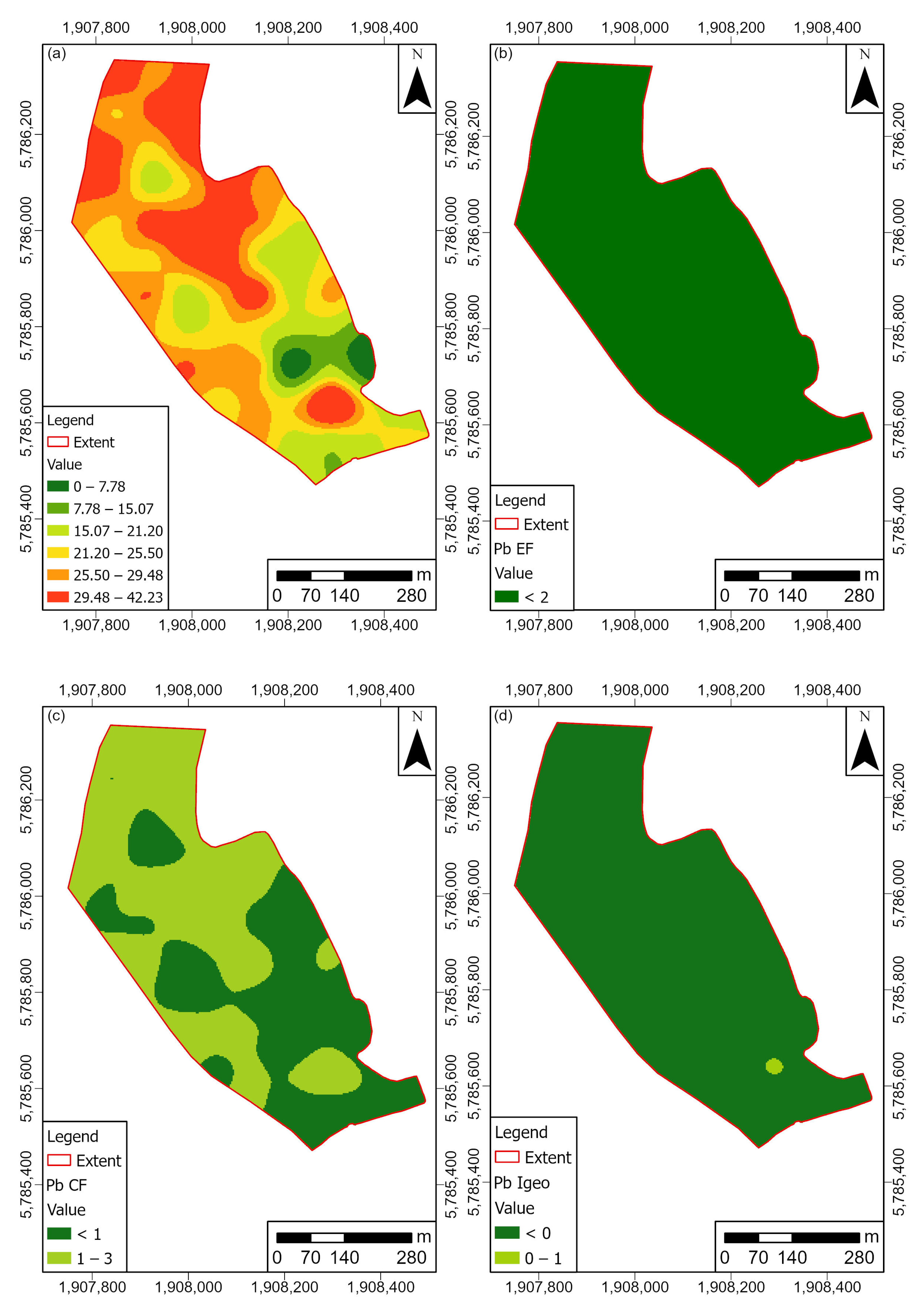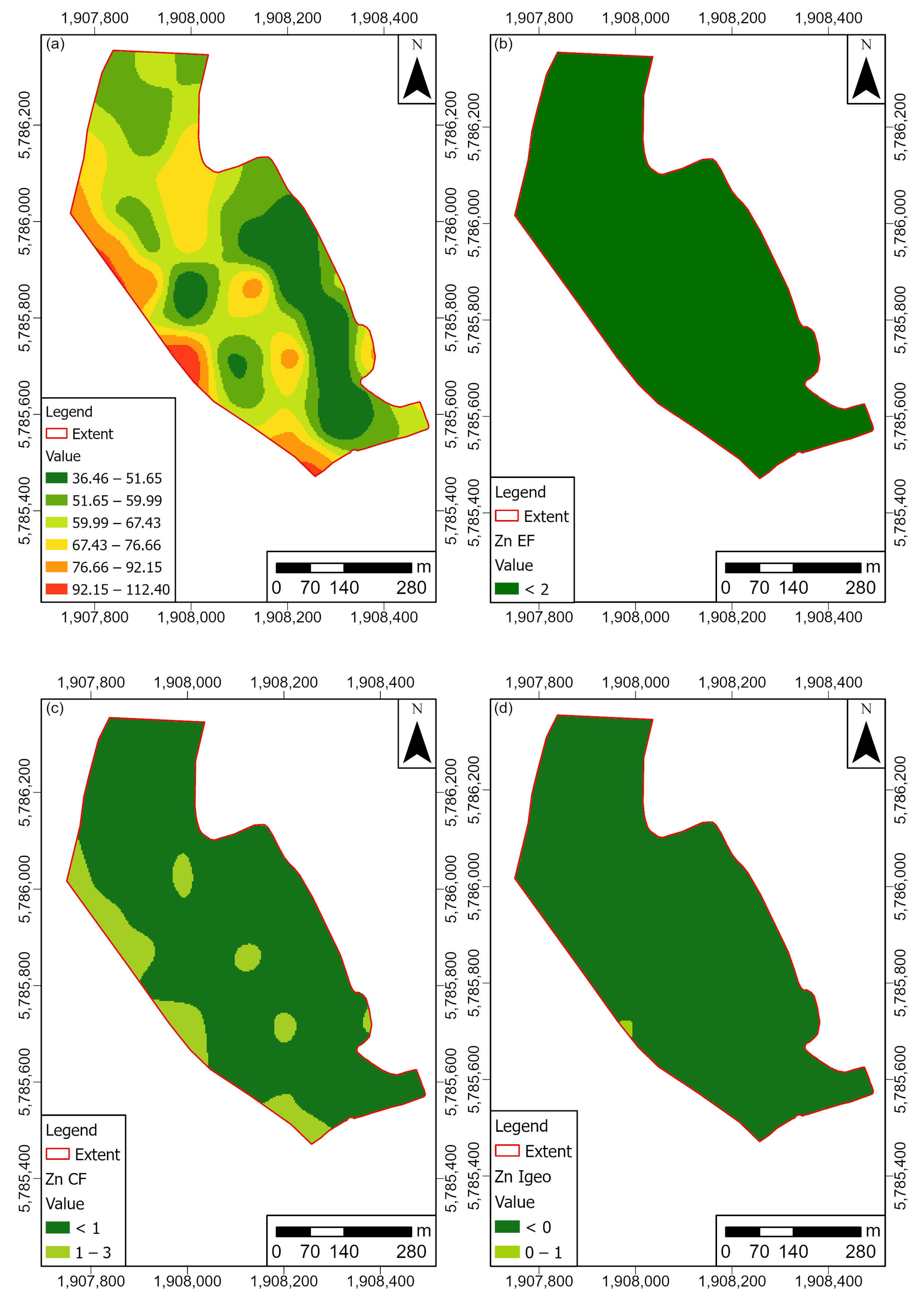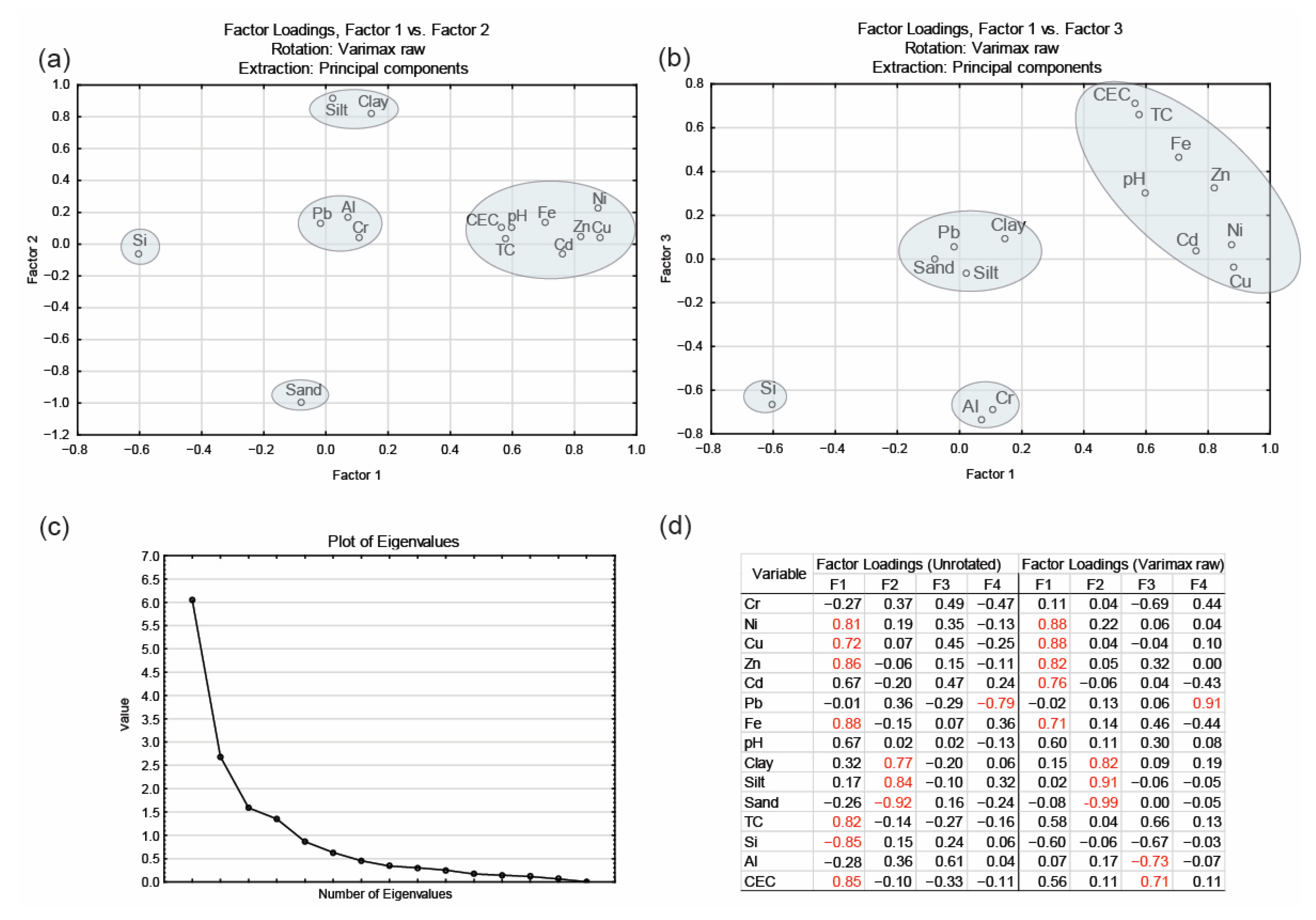Geochemical Factors as a Tool for Distinguishing Geogenic from Anthropogenic Sources of Potentially Toxic Elements in the Soil
Abstract
1. Introduction
2. Geological and Pedological Characteristics of the Area
3. Materials and Methods
3.1. Sampling and Sample Preparation
3.2. Laboratory Work
3.3. Geochemical Factors
3.4. Spatial and Statistical Analyses
4. Results
4.1. Geochemistry of Soils
4.2. Spatial Distribution of PTEs and Geochemical Factors
4.3. Statistical Analyses
5. Discussion
5.1. Geogenic and Anthropogenic Sources of PTEs
5.2. Influence of Soil Parameters on PTE Mobility
6. Conclusions
Supplementary Materials
Author Contributions
Funding
Data Availability Statement
Acknowledgments
Conflicts of Interest
References
- Adimalla, N.; Qian, H.; Nandan, M.J.; Hursthouse, A.S. Potentially toxic elements (PTEs) pollution in surface soils in a typical urban region of south India: An application of health risk assessment and distribution pattern. Ecotoxicol. Environ. Saf. 2020, 203, 111055. [Google Scholar] [CrossRef] [PubMed]
- Ružičić, S.; Balaž, B.-I.; Kovač, Z.; Filipović, L.; Nakić, Z.; Kopić, J. Nickel and Chromium Origin in Fluvisols of the Petruševec Well Field, Zagreb Aquifer. Environments 2022, 9, 154. [Google Scholar] [CrossRef]
- Dong, R.; Jia, Z.; Li, S. Risk assessment and sources identification of soil heavy metals in a typical county of Chongqing Municipality, Southwest China. Process Saf. Environ. 2018, 113, 275–281. [Google Scholar] [CrossRef]
- Ni, M.; Mao, R.; Jia, Z.; Dong, R.; Li, S. Heavy metals in soils of Hechuan County in the upper Yangtze (SW China): Comparative pollution assessment using multiple indices with high-spatial resolution sampling. Ecotoxicol. Environ. Saf. 2018, 148, 644–651. [Google Scholar] [CrossRef] [PubMed]
- Antoniadis, V.; Levizou, E.; Shaheen, S.M.; Ok, Y.S.; Sebastian, A.; Baum, C.; Prasad, M.N.V.; Wenzel, W.W.; Rinklebe, J. Trace elements in the soil-plant interface: Phytoavailability, translocation, and phytoremediationda review. Earth Sci. Rev. 2017, 171, 621–645. [Google Scholar] [CrossRef]
- Kumar, V.; Sharma, A.; Kaur, P.; Sidhu, G.P.S.; Bali, A.S.; Bhardwaj, R.; Thukral, A.K.; Cerda, A. Pollution assessment of heavy metals in soils of India and ecological risk assessment: A state-of-the-art. Chemosphere 2019, 216, 449–462. [Google Scholar] [CrossRef] [PubMed]
- Huang, Y.; Chen, Q.; Deng, M.; Japenga, J.; Li, T.; Yang, X.; He, Z. Heavy metal pollution and health risk assessment of agricultural soils in a typical peri-urban area in southeast China. J. Environ. Manag. 2018, 207, 159–168. [Google Scholar] [CrossRef] [PubMed]
- Birch, G.A. Scheme for Assessing Human Impacts on Coastal Aquatic Environments Using Sediments. In Coastal GIS; Woodcoffe, C.D., Furness, R.A., Eds.; Wollongong University Papers in Center for Maritime Policy: Wollongong, Australia, 2003. [Google Scholar]
- Chen, T.B.; Zheng, Y.M.; Lei, M.; Huang, Z.C.; Wu, H.T.; Chen, H.; Fan, K.; Yu, K.K.; Wu, X.; Tian, Q.Z. Assessment of heavy metal pollution in surface soils of urban parks in Beijing, China. Chemosphere 2005, 60, 542–551. [Google Scholar] [CrossRef]
- Sun, Y.; Zhou, Q.; Xie, X.; Liu, R. Spatial, source and risk assessment of heavy metal contamination of urban soils in typical regions of Shenyang. China. J. Hazard. Mat. 2010, 174, 455–462. [Google Scholar] [CrossRef] [PubMed]
- Sun, C.; Liu, J.; Wang, Y.; Sun, L.; Yu, H. Multivariate and geostatistical analyses of the spatial distribution and sources of heavy metals in agricultural soil in Dehui, Northeast China. Chemosphere 2013, 92, 517–523. [Google Scholar] [CrossRef] [PubMed]
- Wei, B.; Yang, L. A review of heavy metal contaminations in urban soils, urban road dusts and agricultural soils from China. Microchem J. 2010, 94, 99–107. [Google Scholar] [CrossRef]
- Dragovic, S.; Mihailovic, N.; Gajic, B. Heavy metals in soils: Distribution, relationship with soil characteristics and radionuclides and multivariate assessment of contamination sources. Chemosphere 2008, 72, 491–495. [Google Scholar] [CrossRef] [PubMed]
- Yaylalı-Abanuz, G. Heavy metal contamination of surface soil around Gebze industrial area, Turkey. Microchem. J. 2011, 99, 82–92. [Google Scholar] [CrossRef]
- Taghipour, H.; Mosaferi, M.; Armanfar, F.; Gaemmagami, S.J. Heavy metals pollution in the soils of suburban areas in big cities: A case study. J. Environ. Sci. Techn. 2013, 10, 243–250. [Google Scholar] [CrossRef]
- Blaser, P.; Zimmermann, S.; Luster, J.; Shotyk, W. Critical examination of trace element enrichments and depletions in soils: As, Cr, Cu, Ni, Pb, and Zn in Swiss forest soils. Sci. Total. Environ. 2000, 249, 257–280. [Google Scholar] [CrossRef] [PubMed]
- Bourennane, H.; Douay, F.; Sterckeman, T.; Villanneau, E.; Ciesielski, H.; King, D.; Baize, D. Mapping of anthropogenic trace elements inputs in agricultural topsoil from Northern France using enrichment factors. Geoderma 2010, 157, 165–174. [Google Scholar] [CrossRef]
- Reimann, C.; De Caritat, P. Intrinsic flaws of element enrichment factors (EFs) in environmental geochemistry. Environ. Sci. Technol. 2000, 34, 5084–5091. [Google Scholar] [CrossRef]
- Reimann, C.; De Caritat, P. Distinguishing between natural and anthropogenic sources for elements in the environment: Regional geochemical surveys versus enrichment factors. Sci. Total Environ. 2005, 337, 91–107. [Google Scholar] [CrossRef] [PubMed]
- Soubrand-Colin, M.; Neel, C.; Bril, H.; Grosbois, C.; Caner, L. Geochemical behaviour of Ni, Cr, Cu, Zn and Pb in an Andosol–Cambisol climosequence on basaltic rocks in the French Massif Central. Geoderma 2007, 137, 340–351. [Google Scholar] [CrossRef]
- Shui, L.; Pan, X.; Chen, X.; Chang, F.; Wan, D.; Liu, D.; Hu, M.; Li, S.; Wang, Y. Pollution characteristics and ecological risk assessment of heavy metals in sediments of the three gorges reservoir. Water 2020, 12, 1798. [Google Scholar] [CrossRef]
- Wdowczyk, A.; Tomczyk, P.; Szymańska-Pulikowska, A.; Wiatkowska, B.; Rosik-Dulewska, C. Copper and cadmium content in Polish soil: Analysis of 25-year monitoring study. Land Degrad. Dev. 2023, 34, 4857–4868. [Google Scholar] [CrossRef]
- Muller, G. Index of geoaccumulation in the sediments of the Rhine River. Geojournal 1969, 2, 108–118. [Google Scholar]
- Pekey, H.; Karakas, D.; Ayberk, S.; Tolun, L.; Bakoglu, M. Ecological risk assessment using trace elements from surface sediments of Izmit Bay (Northeastern Marmara Sea) Turkey. Mar. Poll. Bull. 2004, 48, 946–953. [Google Scholar] [CrossRef] [PubMed]
- Said, I.; Salman, S.A.; Elnazer, A.A. Multivariate statistics and contamination factor to identify trace elements pollution in soil around Gerga City, Egypt. Bull. Natl. Res. Cent. 2019, 43, 43. [Google Scholar] [CrossRef]
- Halamić, J.; Miko, S. Geochemical Atlas of the Republic of Croatia; Croatian Geological Survey: Zagreb, Croatia, 2009; p. 87. [Google Scholar]
- Feletar, D.; Feletar, P. The Natural Basis as a Factor of the Inhabitation of the Upper Croatian Podravina Region. Podravina 2008, 2, 167–212. [Google Scholar]
- Brenko, T.; Borojević Šoštarić, S.; Ružičić, S.; Sekelj Ivančan, T. Evidence for the formation of bog iron ore in soils of the Podravina region, NE Croatia: Geochemical and mineralogical study. Quarter. Intern. 2020, 536, 13–29. [Google Scholar] [CrossRef]
- Prelogović, E.; Velić, I. Kvartarna tektonska aktivnost zapadnog dijela Dravske depresije (eng. Quaternary tectonic activity of western part of the Drava basin). Geološki Vjesn. 1988, 42, 287–299. (In Croatian) [Google Scholar]
- Šimunić, A.; Hećimović, I.; Avanić, R. Basic Geological Map of the Republic of Croatia, M 1:100 000, Sheet Koprivnica (L33-70); Croatian Geological Survey: Zagreb, Croatia, 1990. [Google Scholar]
- IUSS Working Group WRB. World Reference Base for Soil Resources 2014, Update 2015—International Soil Classification System for Naming Soils and Creating Legends for Soil Maps; World Soil Resources Reports No. 106; FAO: Rome, Italy, 2015. [Google Scholar]
- Husnjak, S. Sistematika Tala Hrvatske (Eng. Soil Systematics of Croatia); University of Zagreb: Zagreb, Hrvatska, 2014. [Google Scholar]
- Varol, M.; Sünbül, M.R.; Aytop, H.; Yılmaz, C.H. Environmental, ecological and health risks of trace elements, and their sources in soils of Harran Plain, Turkey. Chemosphere 2020, 245, 125592. [Google Scholar] [CrossRef] [PubMed]
- Loska, K.; Wiechula, D.; Barska, B.; Cebula, E.; Chojnecka, A. Assessment of arsenic enrichment of cultivated soils in Southern Poland. Pol. J. Environ. Stud. 2003, 12, 187–192. [Google Scholar]
- Loska, K.; Wiechulła, D.; Korus, I. Metal contamination of farming soils affected by industry. Environ. Int. 2004, 30, 159–165. [Google Scholar] [CrossRef] [PubMed]
- Schiff, K.C.; Weisberg, S.B. Iron as a reference element for determining trace metal enrichment in Southern California coast shelf sediments. Mar. Environ. Res. 1999, 48, 161–176. [Google Scholar] [CrossRef]
- Neto, B.J.A.; Smith, B.J.; McAllister, J.J. Heavy metal concentrations in surface sediments in a near shore environment Jurujuba Sound Southeast Brazil. Environ. Poll. 2000, 109, 1–9. [Google Scholar] [CrossRef] [PubMed]
- Mucha, A.P.; Vasconcelos, M.T.S.D.; Bordalo, A.A. Macrobenthic community in the Douro Estuary: Relations with trace metals and natural sediment characteristics. Environ. Poll. 2003, 121, 169–180. [Google Scholar] [CrossRef] [PubMed]
- Barbieri, M. The Importance of Enrichment Factor (EF) and Geoaccumulation Index (Igeo) to Evaluate the Soil Contamination. J. Geol. Geophys. 2016, 5, 1000237. [Google Scholar] [CrossRef]
- Rajmohan, N.; Prathapar, S.A.; Jayaprakash, M.; Nagarajan, R. Vertical distribution of heavy metals in soil profile in a seasonally waterlogging agriculture field in Eastern Ganges Basin. Environ. Monitor. Assess. 2014, 186, 5411–5427. [Google Scholar] [CrossRef] [PubMed]
- Ružičić, S.; Puljko, M.; Brenko, T. Spatial and statistical analyses of parameters influencing arsenic distribution in the lowland Drava River area, northeastern Croatia. Environ. Earth Sci. 2023, 82, 403. [Google Scholar] [CrossRef]
- Alloway, B.J. Heavy Metals in Soils, 2nd ed.; Blackie Academic & Professional: London, UK, 1995. [Google Scholar]
- Izbicki, J.A.; Ball, J.W.; Bullen, T.D.; Sutley, S.J. Chromium, chromium isotopes and selected traced elements, western Mojave Desert, USA. Appl. Geochem. 2008, 23, 1325–1352. [Google Scholar] [CrossRef]
- Morrison, J.M.; Goldhaber, M.B.; Lee, L.; Holloway, J.M.; Wanty, R.B.; Wolf, R.E.; Ranville, J.F. A regional-scale study of chromium and nickel in soils of northern California, USA. Appl. Geochem. 2009, 24, 1500–1511. [Google Scholar] [CrossRef]
- Morrison, J.M.; Goldhaber, M.B.; Mills, C.T.; Breit, G.N.; Hooper, R.L.; Holloway, J.M.; Diehl, S.F.; Ranville, J.F. Weathering and transport of chromium and nickel from serpentinite in the Coast Range ophiolite to the Sacramento Valley, California, USA. Appl. Geochem. 2015, 61, 72–86. [Google Scholar] [CrossRef]
- Bigalke, M.; Ulrich, A.; Rehmus, A.; Keller, A. Accumulation of cadmium and uranium in arable soils in Switzerland. Environ. Pollut. 2017, 221, 85–93. [Google Scholar] [CrossRef] [PubMed]
- Mirlean, N.; Roisenberg, A. The effect of emissions of fertilizer production on the environment contamination by cadmium and arsenic in southern Brazil. Environ. Pollut. 2006, 143, 335–340. [Google Scholar] [CrossRef] [PubMed]
- Sprynskyy, M.; Kowalkowski, T.; Tutu, H.; Cozmuta, L.M.; Cukrowska, E.M.; Buszewski, B. The adsorption properties of agricultural and forest soils towards heavy metal ions (Ni, Cu, Zn, and Cd). Soil Sediment Contam. 2011, 20, 12–29. [Google Scholar] [CrossRef]
- Grant, C.A. Influence of phosphate fertilizer on cadmium in agricultural soils and crops. Pedologist 2011, 3, 143–155. [Google Scholar] [CrossRef]
- Ružičić, S.; Kovač, Z.; Borovčak, T. Possible Influence of Agriculture on an Unsaturated Zone in Croatia. Pol. J. Environ. Stud. 2019, 28, 4341–4349. [Google Scholar] [CrossRef]
- Panagopoulos, I.; Karayannis, A.; Kollias, K.; Xenidis, A.; Papassiopi, N. Investigation of Potential Soil Contamination with Cr and Ni in Four Metal Finishing Facilities at Asopos Industrial Area. J. Hazard. Mater. 2015, 281, 20–25. [Google Scholar] [CrossRef] [PubMed]
- Sarkar, A.; Rano, R.; Udaybhanu, G.; Basu, A.K.A. Comprehensive Characterization of Fly Ash from Thermal Power Plant in Eastern India. Fuel Process. Technol. 2006, 87, 259–277. [Google Scholar] [CrossRef]
- Poznanović Spahić, M.M.; Sakan, S.; Glavaš-Trbić, B.M.; Tančić, P.; Škrivanj, S.; Kovacevic, J.; Manojlović, D.D. Natural and anthropogenic sources of chromium, nickel and cobalt in soils impacted by agricultural and industrial activity (Vojvodina, Serbia). J. Environ. Sci. Health Toxic/Hazard. Part A 2019, 54, 219–230. [Google Scholar] [CrossRef] [PubMed]
- Kuklová, M.; Kukla, J.; Hniličková, H.; Hnilička, F.; Pivková, I. Impact of Car Traffic on Metal Accumulation in Soils and Plants Growing Close to a Motorway (Eastern Slovakia). Toxics 2022, 10, 183. [Google Scholar] [CrossRef] [PubMed]
- Bonten, L.T.C.; Römkens, P.F.A.M.; Brus, D.J. Contribution of heavy metal leaching from agricultural soils to surface water loads. Environ. Forensics 2008, 9, 252–257. [Google Scholar] [CrossRef]
- Schipper, P.N.M.; Bonten, L.T.C.; Plette, A.C.C.; Moolenaar, S.W. Measures to diminish leaching of heavy metals to surface waters from agricultural soils. Desalination 2008, 226, 89–96. [Google Scholar] [CrossRef]
- Kabata-Pendias, A. Trace Elements in Soils and Plants, 4th ed.; CRC Press: Boca Raton, FL, USA, 2011. [Google Scholar]
- Grigalavičienė, I.; Rutkovienė, V.; Marozas, V. The Accumulation of Heavy Metals Pb, Cu and Cd at Roadside Forest Soil. Pol. J. Environ. Stud. 2005, 14, 109–115. [Google Scholar]
- Sollitto, D.; Romic, M.; Castrignanò, A.; Romic, D.; Bakic, H. Assessing heavy metal contamination in soils of the Zagreb region (Northwest Croatia) using multivariate geostatistics. Catena 2010, 80, 182–194. [Google Scholar] [CrossRef]
- Jiries, A.G.; Hussein, H.H.; Halash, Z. The quality of water and sediments of street runoff in Amman, Jordan. Hydrolog. Proc. 2001, 15, 815–824. [Google Scholar] [CrossRef]
- Palansooriya, K.N.; Shaheen, S.M.; Chen, S.S.; Tsang, D.C.W.; Hashimoto, Y.; Hou, D.; Bolan, N.S.; Rinklebe, J.; Ok, Y.S. Soil amendments for immobilization of potentially toxic elements in contaminated soils: A critical review. Environ. Int. 2020, 134, 105046. [Google Scholar] [CrossRef] [PubMed]
- Sparks, D.; Singh, B.; Siebecker, M.G. Environmental Soil Chemistry; Elsevier: Amsterdam, The Netherland, 2003; p. 447. [Google Scholar] [CrossRef]
- Grisso, R.; Allex, M.; Holshouser, D.; Thomason, W. Precision Farming Tools: Soil Electrical Conductivity; Virginia State University Cooperative Extension: Petersburg, VA, USA, 2005; pp. 442–508. [Google Scholar]
- Rinklebe, J.; Shaheen, S.M.; Yu, K. Release of As, Ba, Cd, Cu, Pb, and Sr under pre-definite redox conditions in different rice paddy soils originating from the U.S.A. and Asia. Geoderma 2016, 270, 21–32. [Google Scholar] [CrossRef]
- Sipos, P.; Choi, C.; Németh, T.; Szalai, Z.; Póka, T. Relationship between iron and trace metal fractionation in soils. Chem. Speciat. Bioavailab. 2014, 26, 21–30. [Google Scholar] [CrossRef]
- Antoniadis, V.; Shaheen, S.M.; Tsadilas, C.D.; Selim, M.H. Zinc sorption by different soils as affected by selective removal of carbonates and hydrous oxides. Appl. Geochem. 2018, 88, 49–58. [Google Scholar] [CrossRef]









| Variable | Cr | Ni | Cu | Zn | Cd | Pb | Fe | pH * | Clay * | Silt * | Sand * | TC | Si * | Al * | CEC * |
|---|---|---|---|---|---|---|---|---|---|---|---|---|---|---|---|
| Cr | 1.00 | ||||||||||||||
| Ni | 0.06 | 1.00 | |||||||||||||
| Cu | 0.12 | 0.79 | 1.00 | ||||||||||||
| Zn | −0.24 | 0.75 | 0.69 | 1.00 | |||||||||||
| Cd | −0.14 | 0.61 | 0.57 | 0.63 | 1.00 | ||||||||||
| Pb | 0.19 | 0.07 | 0.05 | 0.08 | −0.32 | 1.00 | |||||||||
| Fe | −0.40 | 0.67 | 0.56 | 0.70 | 0.67 | −0.37 | 1.00 | ||||||||
| pH * | −0.13 | 0.46 | 0.41 | 0.50 | 0.35 | 0.07 | 0.55 | 1.00 | |||||||
| Clay * | 0.11 | 0.30 | 0.19 | 0.12 | 0.03 | 0.24 | 0.20 | 0.17 | 1.00 | ||||||
| Silt * | 0.05 | 0.24 | 0.06 | 0.10 | −0.04 | 0.10 | 0.10 | 0.09 | 0.54 | 1.00 | |||||
| Sand * | −0.09 | −0.30 | −0.13 | −0.12 | 0.01 | −0.17 | −0.16 | −0.14 | −0.82 | −0.93 | 1.00 | ||||
| TC | −0.25 | 0.49 | 0.48 | 0.67 | 0.37 | 0.08 | 0.67 | 0.56 | 0.17 | 0.03 | −0.09 | 1.00 | |||
| Si * | 0.29 | −0.61 | −0.48 | −0.66 | −0.47 | −0.03 | −0.74 | −0.52 | −0.23 | −0.01 | 0.11 | −0.77 | 1.00 | ||
| Al * | 0.30 | −0.06 | −0.02 | −0.14 | −0.03 | 0.00 | −0.22 | 0.03 | 0.05 | 0.17 | −0.13 | −0.38 | 0.47 | 1.00 | |
| CEC * | −0.38 | 0.52 | 0.47 | 0.68 | 0.39 | 0.12 | 0.69 | 0.63 | 0.27 | 0.03 | −0.15 | 0.83 | −0.76 | −0.37 | 1.00 |
Disclaimer/Publisher’s Note: The statements, opinions and data contained in all publications are solely those of the individual author(s) and contributor(s) and not of MDPI and/or the editor(s). MDPI and/or the editor(s) disclaim responsibility for any injury to people or property resulting from any ideas, methods, instructions or products referred to in the content. |
© 2024 by the authors. Licensee MDPI, Basel, Switzerland. This article is an open access article distributed under the terms and conditions of the Creative Commons Attribution (CC BY) license (https://creativecommons.org/licenses/by/4.0/).
Share and Cite
Brenko, T.; Ružičić, S.; Radonić, N.; Puljko, M.; Cvetković, M. Geochemical Factors as a Tool for Distinguishing Geogenic from Anthropogenic Sources of Potentially Toxic Elements in the Soil. Land 2024, 13, 434. https://doi.org/10.3390/land13040434
Brenko T, Ružičić S, Radonić N, Puljko M, Cvetković M. Geochemical Factors as a Tool for Distinguishing Geogenic from Anthropogenic Sources of Potentially Toxic Elements in the Soil. Land. 2024; 13(4):434. https://doi.org/10.3390/land13040434
Chicago/Turabian StyleBrenko, Tomislav, Stanko Ružičić, Niko Radonić, Martina Puljko, and Marko Cvetković. 2024. "Geochemical Factors as a Tool for Distinguishing Geogenic from Anthropogenic Sources of Potentially Toxic Elements in the Soil" Land 13, no. 4: 434. https://doi.org/10.3390/land13040434
APA StyleBrenko, T., Ružičić, S., Radonić, N., Puljko, M., & Cvetković, M. (2024). Geochemical Factors as a Tool for Distinguishing Geogenic from Anthropogenic Sources of Potentially Toxic Elements in the Soil. Land, 13(4), 434. https://doi.org/10.3390/land13040434







